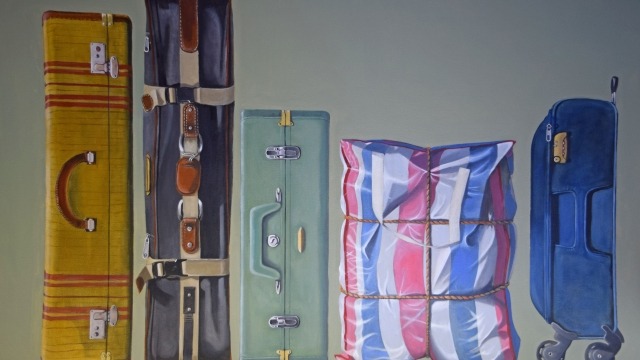2/2016: Visual Arts Graduate Season
Date & time
Reception
Location
SHARE

Exhibition Three
Michael Edwards | Painting | Doctor of Philosophy
My art practice investigates the genre of still life painting. This exhibition reflects my practice-led research into how I can explore and model my response to Australia’s current economic conditions through studio-based painting. I examine traditional still life painting motifs and investigate how elements such as symbolism and space can be applied, adapted and extended to reflect the contemporary world.
Michael Edwards is a Canberra-based artist who graduated with a first class Honours degree from the School of Art in 2006. His work has been exhibited in solo and group
exhibitions in Sydney, including at the Brenda May Gallery, as well as elsewhere in New South Wales. His previous career focused on economic analysis. This experience
influenced his interest in representing the relationship between objects, material culture and the economic environment.
Bryan Spier | Painting | Doctor of Philosophy
The works in this exhibition explore the possibilities of using narrative structure to generate abstract artworks. Narrative is usually associated with realism and is
seemingly the antithesis of abstraction, therefore my proposition is an inherently challenging one. I negotiate this challenge with the assistance of narrative theory that distills narrative to its essential formal components and reveals it to be an abstract structure, one that mediates and summarises real or imagined events to make them conform to the material limits of an artwork. I then use these components to motivate relationships between non-figurative shapes and colours, experimenting with a variety of different media and approaches to synthesise these concepts into new artworks. The exhibition provides a summary of these wide ranging experiments, encompassing rudimentary sketches, montage, scanography, assemblage, and large scale paintings. These artworks begin as reductive abstraction that conforms to the material limits of the flat picture plane, yet by applying narrative concepts they expand to project speculative histories and alternative versions of themselves.
Bryan Spier uses paintings, installation, drawing and video to explore the possibilities of abstraction as the subject of narrative. Spier received his undergraduate degree from the Canberra School of Art before relocating to Melbourne in 2000. In 2005 he received a Masters degree from the Victorian College of the Art before embarking on PhD studies at the Australian National University. Since his first solo exhibition in 1999 Spier has exhibited regularly in Australia and internationally. He has been included in many group exhibitions, with highlights including Abstract Now at the Shepperton Art Gallery, Colour Bazaar at Heide Museum of Modern Art, Shifting Geometries at the Australian Embassy in Washington D.C, and Certain Abstract Things at the Griffith University Art Gallery in Brisbane. Recent solo exhibitions include Pretend Paintings at the Gippsland Art Gallery, and History Paintings at Sarah Scout Gallery.

Bryan Spier, image courtesy of the artist
Genevieve Swifte | Photography and Media Arts | Doctor of Philosophy
Cathryn Vasseleu writes of the exquisite tactility of light via an evocation of sensations such as penetration, dazzlement, ecstasy and pain.1 This concept, encountered early in my candidacy, became something of a technical guide to the operation of my camera, a methodology for practice-led research through which the sensuous qualities of light might inform the making of a photograph.
Such close attention to the exquisite nature of light altered also my processes of observation. By attending to the behaviour of light in the photography of Francesca Woodman and the materiality of her imagery, my research finds that Woodman’s photography taps into a significant moment in the history of contemporary studio glass and the early years of the renowned Pilchuck Glass School. This aspect of Woodman’s practice, which is absent from the immense body of literature concerned with her photography, calls for a deeper reading informed by theories of light that may be shared equally between the materiality of both glass and photography.
The photographic works that are the outcomes of my studio research take this finding as a point of departure, deepening my exploration into the iconography of Woodman’s imagery by passing through Michael Fried’s kaleidoscopic readings of Caravaggio’s paintings, representations of the body and grace in Ancient Roman and Renaissance art and feminist theory. In this way my studio practice shifted from subjects of the sublime and of landscape, spiralling tightly inwards before coming to rest in a poetic re-configuration of self-portraiture.
1. Cathryn Vasseleu, Textures of Light; Vision and Touch in Irigaray, Levinas and Merleau-Ponty, (London: Routledge, 1998). 12.
Genevieve Swifte is an award winning contemporary artist who’s practice-led research explores transgressions of sensory experience and embodiment via lens-based imagery. Emerging from the darkroom of an alternative school in the 1990s, Swifte’s sensibilities are also informed by an undergraduate degree in drawing and printmaking, interdisciplinary collaborations and residencies in remote corners of the globe. Recent exhibitions include The Poetic Lens at Tamworth Regional Gallery; Quotidean, Elements of the Everyday: Water, CelerySpace, Berkeley, California; Sur Polar: Arte en Antarctica, Galeria de Arte Contemporaneo de Xalapa, Mexico and the Museo de Arte Tigre, Buenos Aries, Argentina.
The recipient of numerous grants and awards, Swifte’s works are held in public collections in Australia and internationally.











